
Pyrus communis, known as the common pear, is a species of pear native to West Asia, central and eastern Europe.

Glyptostrobus pensilis, known in Chinese as 水松, and also Chinese swamp cypress, is the sole living species in the genus Glyptostrobus. It is native to subtropical southeastern China, from Fujian west to southeast Yunnan, and also very locally in northern Vietnam and Laos.

Pyrus salicifolia is a species of pear, native to the Middle East. It is widely grown as an ornamental tree, almost always as a pendulous cultivar, and is called by various common names, including willow-leaved pear, weeping pear, and similar. The tree is deciduous and of comparatively small stature, rarely reaching 10–12 meters in height. The crown is rounded. It has pendulous, silvery foliage, superficially similar to a weeping willow. The flowers are large and pure white highlighted with black-tipped stamens although the buds are tipped with red. The small green fruits are inedible, being hard and astringent.
Cotylelobium melanoxylon is a tree in the family Dipterocarpaceae. The specific epithet melanoxylon means "black wood", referring to the dark colour of the tree's wood. It was first described by Joseph Dalton Hooker in 1860 as Anisoptera melanoxylon and transferred to Cotylelobium by Jean Baptiste Louis Pierre in 1889. It is the provincial tree of Surat Thani Province, Thailand.

Ulmus castaneifoliaHemsley, the chestnut-leafed elm or multinerved elm, is a small deciduous tree found across much of China in broadleaved forests at elevations of 500–1,600 metres (1,600–5,200 ft).

Crateva religiosa, the sacred garlic pear or temple plant, is a species of flowering tree. It is a member of the capers family. The tree is sometimes called the spider tree because the showy flowers bear long, spidery stamens. It is native to much of tropical Asia and several South Pacific islands. It is grown elsewhere for fruit, especially in parts of the African continent.
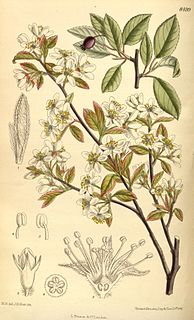
Amelanchier bartramiana is a species of serviceberry. Common names include mountain serviceberry, mountain shadbush, Bartram's serviceberry, mountain juneberry, Bartram juneberry, and the oblongfruit serviceberry.

Malus angustifolia, or southern crabapple, is a species of crabapple native to the eastern and south-central United States from Florida west to eastern Texas and north to New Jersey, Pennsylvania, Illinois and Missouri.
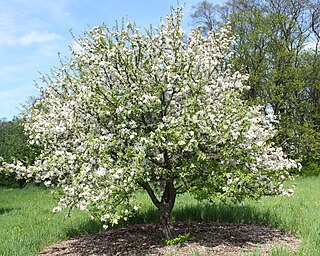
Malus prunifolia is a species of crabapple tree known by the common names plumleaf crab apple, plum-leaved apple, pear-leaf crabapple, Chinese apple and Chinese crabapple. It is native to China, and is grown elsewhere for use as an ornamental tree or as rootstock. It reaches from between 3 and 8 meters tall and bears white flowers and yellow or red fruit.
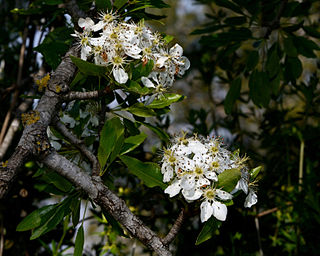
Pyrus syriaca is a deciduous tree in the Rosaceae family. It is referred to by the common name Syrian pear. It is the only pear species which grows in the wild in Lebanon, Turkey, Syria and Israel.

Tabernaemontana pandacaqui, known as windmill bush and banana bush, is a species of plant in the dogbane family Apocynaceae.

Kopsia arborea is a tree in the family Apocynaceae.
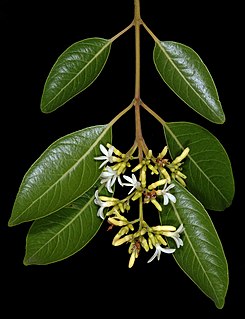
Diplorhynchus is a monotypic genus of plant in the family Apocynaceae native to tropical and southern Africa. As of August 2020, Plants of the World Online recognises the single species Diplorhynchus condylocarpon.
Symplocos anomala is a plant in the family Symplocaceae.

Schrebera alata is a plant in the family Oleaceae. It grows as a tree up to 15 m (50 ft) tall. The specific epithet alata is from the Latin meaning "winged", referring to the petioles. Its habitat is forests and woodland from 1,000–1,800 m (3,000–6,000 ft) altitude. Schrebera alata is native Ethiopia, the Democratic Republic of the Congo, Uganda, Rwanda, Burundi, Kenya, Tanzania, Angola, Zambia, Zimbabwe, Malawi, Mozambique, Eswatini and South Africa.

Diospyros maritima is a tree in the family Ebenaceae. The specific epithet maritima means "by the sea", referring to the tree's habitat.

Rhizophora stylosa, the spotted mangrove, red mangrove, small stilted mangrove or stilt-root mangrove, is a tree in the family Rhizophoraceae. The specific epithet stylosa is from the Latin meaning "stylus form", referring to the flower.

Schrebera swietenioides is a flowering plant in the family Oleaceae found in India, Bangladesh, Myanmar, Thailand, Cambodia and Laos. It prefers dry forests. It is commonly known as weaver's beam tree. Other names are mala plasu, muskkakavrksam, maggamaram', manimaram, mushkakavriksham, malamplasu and malamblasu. Flowering season is from February to April.
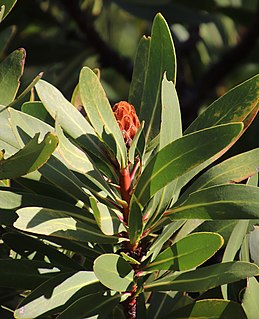
Protea rubropilosa, also known as the Transvaal sugarbush, escarpment sugarbush or Transvaal mountain sugarbush, is a flowering tree, that belongs to the genus Protea in the family Proteaceae. The plant only occurs in South Africa.
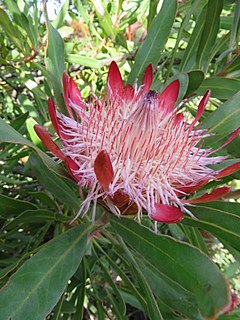
Protea susannae, also known as stink-leaf sugarbush, is a flower-bearing shrub of the genus Protea. The plant is endemic to the southwestern Cape Region of South Africa.


















